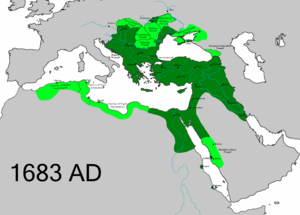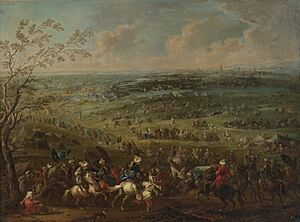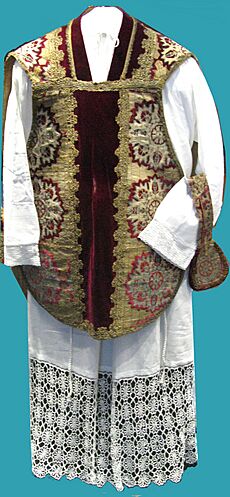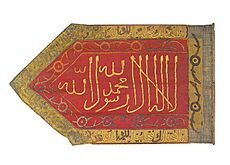Battle of Vienna facts for kids
Quick facts for kids Siege of Vienna |
|||||||||
|---|---|---|---|---|---|---|---|---|---|
| Part of the Great Turkish War, the Ottoman–Habsburg wars, and the Polish–Ottoman War | |||||||||
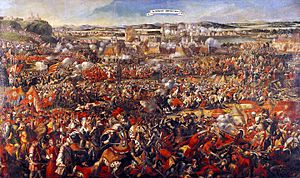 Battle of Vienna, 12 September 1683 |
|||||||||
|
|||||||||
| Belligerents | |||||||||
|
Vassal states:
|
Holy League:
|
||||||||
| Commanders and leaders | |||||||||
| Strength | |||||||||
|
120,000 soldiers to 65,000 soldiers during 60 days of siege with around 60 guns |
Viennese garrison: Relief force:
According to Podhorodecki: Total: |
||||||||
| Casualties and losses | |||||||||
|
Total Casualties: Casualties during the siege: 48,544 killed, 25% desertion and unknown number of deaths from diseases Casualties during the battle: 8,000–20,000 |
Total Casualties: Casualties during the siege: 12,000 Casualties during the battle: 4,500 3,500 dead or wounded (1,300 Poles) |
||||||||
The Battle of Vienna was a huge fight that happened on September 12, 1683. It took place near Vienna, a city that had been surrounded by the Ottoman Empire for two months. This battle was a big deal because it was the first time the Holy Roman Empire (led by the Habsburg monarchy) and the Polish–Lithuanian Commonwealth worked together against the Ottomans.
The Christian forces, led by King John III Sobieski of Poland, won the battle. This victory is often seen as a turning point. It stopped the Ottoman Empire from expanding further into Europe. After this battle, the Ottomans started to lose land, especially in Ottoman Hungary, over the next 16 years.
The main Ottoman army was led by Grand Vizier Kara Mustafa Pasha. They had a huge army, possibly up to 170,000 soldiers at the start of their campaign. They began surrounding Vienna on July 14, 1683. The city's defenders, about 15,000 soldiers and volunteers, were led by Ernst Rüdiger Graf von Starhemberg. The big battle happened on September 12 when the relief army arrived.
Many historians believe this battle changed the course of the 300-year struggle between the Holy Roman and Ottoman Empires. It also featured the largest cavalry charge in history!
Contents
Why the Battle Happened
Capturing Vienna was a big goal for the Ottoman Empire. The city was important because it controlled trade routes along the Danube River and to Germany. Before the siege, the Ottomans, under Grand Vizier Kara Mustafa Pasha, spent a lot of time getting ready. They fixed roads, built bridges, and moved supplies like ammunition and cannons to the area.
The Ottomans had tried to reach Vienna before, but were stopped in 1566. Vienna wasn't threatened again until 1683. In the years leading up to 1683, the Ottoman Empire helped Hungarian groups who were rebelling against the Habsburg rulers. These rebels, led by Imre Thököly, were fighting against the Holy Roman Emperor Leopold I. The Ottomans even promised Vienna to the Hungarians if they captured it.
In 1681 and 1682, fights between Thököly's forces and the Holy Roman Empire became more intense. This gave Kara Mustafa Pasha a reason to convince Sultan Mehmed IV to move the Ottoman army. The Sultan allowed Mustafa Pasha to attack castles in northwestern Hungary. The Ottoman army started moving on January 21, 1682, and war was officially declared on August 6, 1682.
It took a long time for the Ottoman army to reach Vienna. This delay gave Vienna time to prepare its defenses. It also allowed Emperor Leopold to gather troops from the Holy Roman Empire. He also formed an alliance with Poland, Venice, and Pope Innocent XI. This alliance was made official in the 1683 Treaty of Warsaw. In this treaty, Leopold promised to help Poland if the Ottomans attacked Kraków. In return, the Polish army would help Vienna if it was attacked.
On March 31, 1683, Kara Mustafa Pasha sent a message to Vienna demanding surrender. The next day, Ottoman troops began their march from Edirne. They reached Belgrade by early May. They were joined by armies from Transylvania and Hungary. About 40,000 Crimean Tatar troops arrived near Vienna on July 7. Emperor Leopold and his court fled Vienna. The main Ottoman army arrived on July 14. Vienna's defense was left to Count Ernst Rüdiger von Starhemberg and his 15,000 men.
King John III Sobieski of Poland prepared his army to help Vienna. He left Kraków on August 15. While he was marching, most of Poland was left undefended. This allowed Imre Thököly to try an invasion there. The Lithuanian army, another part of the Polish-Lithuanian Commonwealth, was delayed and arrived after Vienna was saved.
There were some disagreements between Poland and the German states, especially Austria, about who would pay for the troops. Sobieski felt he shouldn't have to pay for his army's march since he was saving the city. The Habsburg leaders found money to pay for the German troops and made deals with the Poles to lower their costs.
During the Siege
The main Ottoman army began its siege of Vienna on July 14. Kara Mustafa Pasha demanded that the city surrender. However, Ernst Rüdiger Graf von Starhemberg, leading Vienna's defenders, refused. He had heard about the terrible slaughter at Perchtoldsdorf, a town south of Vienna. Its citizens had surrendered but were killed anyway. The siege operations officially started on July 17.
The people of Vienna had destroyed many houses outside the city walls. This created an open space, making it harder for the Ottomans to approach without being seen and fired upon. In response, Kara Mustafa Pasha ordered his soldiers to dig long trenches directly towards the city. These trenches helped protect them as they moved closer.
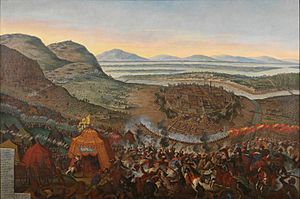
The Ottomans had fewer cannons than the defenders. They also dug tunnels under the city walls. These tunnels were filled with black powder to blow up the walls. The outer wooden fence around Vienna was old and weak. To fix this, the defenders put large tree trunks into the ground around the walls. This slowed down the Ottoman plan for a quick siege by almost three weeks. This delay, along with the Ottomans' slow advance after declaring war, allowed the relief army to arrive in September.
Some historians think Kara Mustafa wanted to capture the city with all its riches still inside. He might have avoided a full-on attack because he didn't want his soldiers to plunder the city, which was usually allowed after a successful assault.
The Ottoman siege cut off almost all food supplies to Vienna. Soldiers became very tired. Von Starhemberg even ordered that any soldier found sleeping on watch would be shot. The defenders were close to giving up. But in August, Imperial forces led by Charles V, Duke of Lorraine, defeated Thököly's forces near Vienna.
On September 6, the Polish army, led by King Sobieski, crossed the Danube River northwest of Vienna. They joined with Imperial troops and forces from Saxony, Bavaria, and other German states. Some mercenary soldiers from Zaporozhian Cossacks also joined them. The King of France, Louis XIV, chose not to help his rival, the Habsburgs.
Sobieski was put in charge of all the European allied forces. He was famous for his experience fighting the Ottoman army. He had won a big victory against them in 1673. Now, he commanded an army of 70,000–80,000 soldiers, facing an Ottoman force of about 150,000.
In early September, about 5,000 skilled Ottoman sappers (soldiers who dig tunnels) blew up large parts of Vienna's walls. This created gaps about 12 meters wide. The Viennese defenders dug their own tunnels to find and disarm the Ottoman mines. The Ottomans finally took over a part of the outer wall on September 8. The remaining Viennese soldiers prepared to fight inside the city.
The Battle Begins
The battle started early, even before all the armies were fully ready. At 4:00 AM on September 12, the Ottoman army attacked. They wanted to stop the Holy League troops from getting into position. The German forces were the first to fight back. Charles of Lorraine led the Imperial army on the left side. After heavy fighting, they captured important places like the villages of Nussdorf and Heiligenstadt. By midday, the Imperial army had hurt the Ottoman forces badly.
At the same time, Șerban Cantacuzino and his soldiers, who secretly supported the Christian side, tried to mess up the Ottoman siege. They left a bridge over the Danube unguarded. This bridge was important for the Ottoman army's left side.
Mustafa Pasha sent most of his forces to counterattack. But he kept some of his best soldiers, like the Janissaries and Sipahi, to attack the city at the same time. The Ottoman leaders had hoped to capture Vienna before Sobieski's army arrived. Their sappers had prepared a huge explosion under the walls. But the defenders found and disarmed ten of these mines.
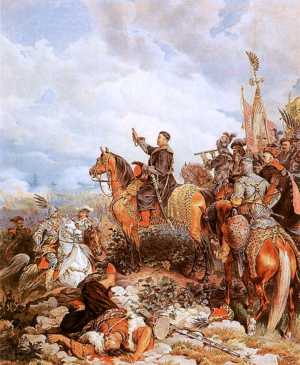
In the early afternoon, a big fight started on the other side of the battlefield. The Polish infantry (foot soldiers) moved forward on the Ottoman right side. Even with the relief army arriving, some Ottoman forces kept trying to break into the city. This allowed the Polish troops to advance. By 4:00 PM, the Poles had captured the village of Gersthof. This village would be a good spot for their cavalry charge. The Ottoman army was now stuck between the Polish and Imperial forces. Charles of Lorraine and John III Sobieski both decided to push forward and defeat the Ottomans.
The German forces started attacking again on the left side at 3:30 PM. At first, they faced strong resistance and couldn't move forward. But by 5:00 PM, they began to advance and took two more villages. Imperial forces were now getting close to the main Ottoman position. As they got ready for a final push, the Polish cavalry began to move.
The Polish cavalry slowly came out of a nearby forest. The infantry soldiers cheered, excited to see them. At 4:00 PM, a small group of 120 hussars (heavy cavalry) charged. They showed that the Ottomans could be attacked, but they also took many losses. They started to get close to the main Ottoman camp. The Ottoman leader decided to leave his position and retreat to his headquarters. But by then, many Ottoman soldiers were already leaving the battlefield.
The relief army was ready for its final attack. Around 6:00 PM, the Polish king ordered the cavalry to charge. Four groups of horsemen, three Polish and one from the Holy Roman Empire, attacked. About 18,000 horsemen charged down the hills. This was the largest cavalry charge in history! Sobieski led the charge with 3,000 Polish heavy lancers, known as the "Winged Hussars". Some Lipka Tatars fighting with the Poles wore straw in their helmets to tell them apart from the Tatars fighting for the Ottomans.
The charge quickly broke through the Ottoman lines. The Ottoman soldiers were already tired and losing hope. They began to run away from the battlefield. The cavalry went straight for the Ottoman camps and Kara Mustafa's headquarters. At the same time, the remaining Viennese soldiers came out of the city to join the attack.
The Ottoman forces were exhausted and discouraged. Their attempts to blow up the city walls had failed. The Holy League infantry was also advancing. Less than three hours after the huge cavalry charge, the Holy League forces had won the battle. They had successfully defended Vienna. The first Catholic officer to enter the city was Louis William, Margrave of Baden-Baden. Sobieski famously said, "Venimus, vidimus, Deus vicit" – "We came, we saw, God conquered."
What Happened After
An Ottoman historian described the battle as a huge defeat for the Ottoman Empire. It was their worst loss since they started in 1299. The Ottomans lost at least 20,000 men during the siege. During the final battle, they lost about 8,000 to 15,000 soldiers, and 5,000 to 10,000 were captured. The relief force under Sobieski had much fewer losses, about 3,500 dead and wounded, including 1,300 Poles. The Viennese defenders and people lost about half of their original number during the siege.
The Holy League troops and the Viennese took a lot of valuable things from the Ottoman army. Sobieski wrote to his wife about the "treasures unheard of." He mentioned tents, sheep, cattle, and many camels. He called it a victory "as nobody ever knew before."
After the battle, Starhemberg immediately ordered repairs to Vienna's damaged walls. He wanted to protect against any possible Ottoman counterattack. However, Vienna was never again attacked by the Ottoman Empire.
Because of his defeat, Kara Mustafa Pasha was executed in Belgrade on December 25.
Even with the victory, there were some disagreements among the commanders. Sobieski wanted Polish troops to have the first pick of the spoils from the Ottoman camp. This meant German and Austrian troops got less. Also, Protestant soldiers from Saxony, who helped save the city, were reportedly insulted by the Catholic people in the countryside. The Saxons left the battle right away and refused to help chase the Ottomans.
Sobieski went on to free some areas in Hungary after another battle. But he had to stop chasing the Ottomans because of illness. Charles V of Lorraine later captured Buda and most of Hungary in 1686. This put southern Hungary and Transylvania under Habsburg control. He also captured Belgrade in 1688.
The Ottoman defeat at Vienna was celebrated in Safavid Iran. The news was so exciting that the Emperor of Persia thought about marching to Baghdad. However, his officials knew that Persia's army was not strong enough. They didn't want the Ottoman Empire to be completely destroyed, as it acted as a buffer against Christian Europe.
Why the Battle Was Important
The victory at Vienna paved the way for the Holy Roman Empire to conquer Hungary and parts of the Balkans in the following years. The Ottomans continued to fight for another 16 years, but they eventually lost control of Hungary and Transylvania. The Holy Roman Empire signed a peace treaty with the Ottoman Empire in 1699. This treaty gave most of Hungary to the Habsburgs. The Battle of Vienna marked the historic end of the Ottoman Empire's expansion into Europe.

Before the battle, Sobieski had asked for protection from the Blessed Virgin Mary. To celebrate his victory, Pope Innocent XI made the feast of the Holy Name of Mary a holiday for the entire Church. It is now celebrated on September 12, the day of the victory. The Pope also added the Polish crowned White Eagle to his coat of arms. After the victory, the Pope gave the Polish king the title "Defender of the Faith." To honor Sobieski, the Austrians built a church on the Kahlenberg hill north of Vienna.
See also
- Great Turkish War
- History of Vienna
- Ottoman wars in Europe
- Scutum: a constellation named in 1684 in reference to the battle
- The Day of the Siege: September Eleven 1683, a 2012 English-language Polish and Italian historical drama film based on the Battle of Vienna and directed by Renzo Martinelli


